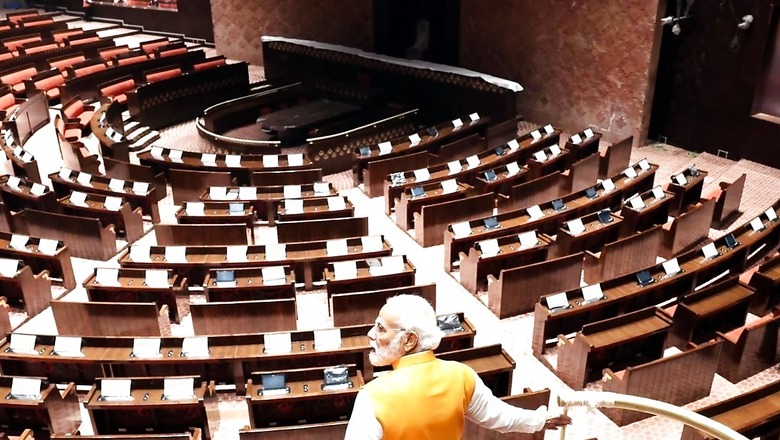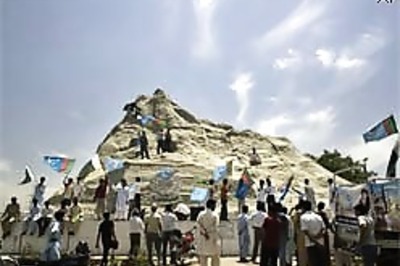
views
The Sengol, received in 1947 from Lord Mountbatten by Pandit Nehru to represent the transfer of power from the British and kept in a rusty museum in Allahabad, will now be installed in the new Parliament building on May 28, 2023.
A beautiful carving of ‘Nandi’ atop the Sengol signifies the concept of justice. When India attained independence from the British, the then Viceroy Lord Mountbatten posed a question to the to-be Prime Minister Jawaharlal Nehru. “What is the ceremony that should be followed to symbolise the transfer of power from British to Indian hands?” Nehru then consulted C Rajagopalachari, popularly known as Rajaji, who went on to become the last Viceroy of India.
Rajaji identified the Chola model where the transfer of power from one king to another was sanctified and blessed with the handover of Sengol or sceptre. A golden sceptre was crafted by Vummidi Bangaru Chetty and family, famous jewellers in the erstwhile Madras Presidency. The ‘handing over’ ceremony that happened on Independence Day eve on August 14, 1947, saw the presence of the deputy high priest of Thiruvavaduthurai Adheenam (a 500 year-old Shaivaite monastery or mutt), Nadaswaram player Rajarathinam Pillai, and an Odhuvar (a person who sings devotional songs in Tamil temples).
All these people were flown to the capital from the Madras Presidency. The ceremony was conducted as per Tamil traditions and the Sengol was handed over to Nehru at his house.
From Nehru’s residence, the Sengol, instead of reaching the Indian Parliament in due course, was reduced to oblivion in a decrepit museum at Prayagraj (Allahabad). Was an attempt made to purge India of its civilizational past by relegating the iconic Sengol to a dusty museum, where it was labelled as the golden “walking stick of Pandit Nehru”? Of course, yes!
The decision to allow the Sengol to rest in the dark corners of an obscure museum was a deliberate attempt by Nehru and his Hinduphobic successors within the Congress Party, to rid India of its vibrant civilisational legacy. But that tragedy is now being undone. Harihara Desika Swamigal, the 293rd head priest of Madurai Adheenam, will be handing over the majestic Sengol to PM Modi on May 28, 2023.
The Modi government is also launching a special Rs 75 coin to commemorate the inauguration of the historic new Parliament building. Remember, the current Parliament building was inaugurated way back in 1927 by Lord Irwin, who represented the British Crown, and was designed by Herbert Baker and Edward Lutyens. The new Parliament building will rightfully erase one of the last traces of India’s colonial past.
The word Sengol is derived from the Tamil word ‘Semmai‘, meaning ‘righteousness’. It is an Indic civilizational practice from the days of the Chola kingdom. What a shame that we Indians had to wait for 76 years to restore the Sengol to its rightful place in Parliament and this excruciating wait is yet another blunder, in the long list of embarrassing blunders by Nehru.
What is even more shameful is the fact that 21 fractious opposition parties have decided to boycott the inauguration of the new Parliament building by Prime Minister Modi, on the lame pretext that President Murmu should have done it. It is surprising that the very Congress party which abused Droupadi Murmu in vile language, with Adhir Ranjan Chowdhury calling her Rashtrapatni, Ajoy Kumar calling her a symbol of the evil philosophy of India, and Udit Raj, yet another Congress leader, calling her a puppet and a chamcha, are today putting up a charade of how sensitised they are to an Adivasi President’s respect and honour.
A misogynistic TMC leader, Akhil Giri, also had the gall to comment on the skin colour of Murmu, but shamefully, he continues to be a close aide of Mamata Banerjee.
In all, the Modi Cabinet has over 27 OBCs (Other Backward Castes), 12 SCs (Dalits) and 8 STs (Adivasis), as ministers, who together constitute 61% of the Cabinet. Hence, the Opposition has no business making baseless and wild allegations that the BJP is anti-Adivasis.
In fact, compared to an annual expenditure on tribal welfare of just Rs 24,000 crore in 2013, today, the annual expenditure on tribal welfare and related schemes by the Modi government, is in excess of Rs 93,000 crore, a solid 288% jump, over 2013. If anything, it is PM Modi who put his entire credibility and weight behind Droupadi Murmu, from the Santhal tribe, to ensure that she won the Presidential election handsomely, against Yashwant Sinha, the Opposition’s candidate.
Also in the last nine years, unlike the Congress, Modi has taken many steps to decouple India from its colonial vestiges. Be it replacing Henry Francis Lyte’s hymn Abide with Me, with Lata Mangeshkar’s Aye Mere Watan Ke Logon, for the Beating the Retreat ceremony held every year at Vijay Chowk, be it installing a 28-foot-tall statue of Netaji Bose at India Gate, in the canopy that was vacated by George V in 1968, be it renaming Aurangzeb Road as APJ Abdul Kalam Marg, be it renaming Rajpath as Kartavyapath or for that matter the decision to have the insignia of Chhatrapati Shivaji Maharaj on INS Vikrant, Prime Minister Modi and his government have always put India and Indian traditions steeped in our glorious history, over and above everything else.
In Modi’s New India, there is no room for any colonial era relics that the erstwhile East India Company foisted upon us. For those who say the Modi government should have shown magnanimity in inviting the Opposition, let it be known that magnanimity is a two-way street. The Central Vista project and the new Parliament building would not have even seen the light of the day had it not been for the dedication and unrelenting commitment of PM Modi and the Supreme Court verdict in June 2021, which upheld the earlier decision of the Delhi High Court on this matter.
The Opposition’s repeated attempts to stonewall the Central Vista project and new Parliament building were dismissed repeatedly by both the Delhi High Court and the Supreme Court.
The sacred Sengol signifies the expectation of fair governance and it is absolutely false to say the Sengol symbolises monarchy or imperialism. Crafted with historical significance, this artefact holds deep cultural value, embodying the ideals of justice and duty, something Nehru, his daughter Indira, his grandson Rajiv and great-grandson Rahul Gandhi have perhaps seldom believed in or subscribed to.
The Sengol is not merely a handshake or signing of a document but beyond all that, is a constant reminder of our local traditions, rich history, great cultural ethos and our ability to blend our glorious traditions and values with our evolving, modern needs.
All 20 Adheenam presidents will be present on the auspicious occasion of inauguration of the new Parliament building on May 28, 2023, to shower their blessings in reminiscence of this sacred ritual that was held in 1947 but was never brought to fruition by Nehru.
With PM Narendra Modi at the helm, the Sengol will get its rightful place next to the Speaker’s podium, with 96-year-old Vummidi Bangaru Chetty associated with the Sengol’s creation, also participating in this sacred ceremony. The new Parliament building is an example of Prime Minister Narendra Modi’s far-sightedness, wherein the PM would honour 60,000 labourers or shramiks at the inauguration.
In a big jolt to the Opposition, the Supreme Court dismissed a plea on May 26 to have President Droupadi Murmu inaugurate the new Parliament building. Neither constitutional law nor convention mandates that the President of India inaugurate a new Parliament building. The President is very much part of Parliament and the Constitution exhaustively prescribes his/her powers in respect of the said institution.
Most of these powers are to be exercised by the President on the aid and advice of the Council of Ministers, led by the Prime Minister and a few are to be exercised in his/her independent discretion. The Constitutional role for the President is concerned with weighty matters of the State, not symbolic acts outside Parliament.
The President is the de-jure head of the State, as per the Constitution. However, under Article 74 (1) and 75 (1), the Prime Minister is the de-facto head of the government and, hence, PM Modi is completely within his rights to inaugurate the new Parliament building. The boycott of the inauguration by a number of opposition parties is, therefore, totally misconceived and yet another act of petty, personal politics. They will not be part of the most significant event in the annals of our Parliament’s history and future generations will only mock them for their churlishness.
Speaking of established protocol, there are a few things that need to be noted. Mamata Banerjee walked away in a huff on January 23, 2021, at an event to honour Netaji Bose, even as PM Modi was still sitting there attending the program and she did that merely because some people in the audience chanted Jai Shree Ram. Was that not a breach of protocol? She disallowed the then West Bengal Governor KN Tripathi from visiting riot-hit victims in Asansol in 2018. Was that not a breach of protocol? She made appointments to the post of Vice-Chancellor in over three dozen universities in West Bengal without the consent or approval of then Governor Jagdeep Dhankar in 2021. Was that not breach of protocol? She repeatedly refuses to attend Niti Aayog’s meetings. Is that not breach of protocol?
As for AAP’s Arvind Kejriwal, he is a national embarrassment. From Najeeb Jung to Anil Baijal to VK Saxena, Kejriwal has fought with every Lieutenant Governor of Delhi, in gross violation of every constitutional protocol and the GNCTD Act of 1991. Following his master’s defiant footsteps, Bhagwant Mann, the CM of Punjab, decided not attend the recently concluded meeting of Niti Aayog. Is that not a breach of protocol?
The less said about Telangana Chief Minister KCR, the better. He and his party, the BRS, have never lost an opportunity to humiliate and disempower Tamilisai Soundararajan, the Governor of Telangana. Tamilisai was not allowed to give her customary Ugadi address, nor allowed to give her customary Republic Day address a few months ago. Her address in the Budget session earlier this year was abruptly cut short, with all the BRS MLAs walking out, showing scant regard for the Chair of the Governor. Was that not a breach of protocol? KCR does not even have the basic decency to welcome or see off the PM at the airport each time the PM has visited Telangana. Is that not breach of protocol?
However, when it comes to breach of protocol, the debilitated Congress party certainly takes the cake. Why did the former Congress president Sonia Gandhi, without holding any government office in India, decide to be the guest of the Chinese government at the Beijing Olympics in 2008? Why did Sonia Gandhi inaugurate the Atal tunnel, the Bandra-Worli sea link and the railway coach factory in Rae Bareli between 2009 and 2010?
Why did she inaugurate the new building of Manipur Legislative Assembly in 2011?
The construction of a new building for Chhattisgarh Vidhan Sabha saw the ground-breaking ceremony being done by Bhupesh Baghel, the Chief Minister, on 29 August, 2020, in the presence of other Congress leaders like Rahul Gandhi and Sonia Gandhi. Why did Baghel inaugurate the ground-breaking ceremony in 2020 without so much as even inviting the Governor?
In fact, no Governor or President had been invited by non-BJP ruled state governments for laying the foundation stones of, or inaugurating new Legislative Assembly buildings, in the last nine years. The foundation stone of the Assembly buildings in Jharkhand and Assam in 2014, in Andhra Pradesh in 2018, in Chhattisgarh in 2020, and in Telangana in 2023 are stark reminders of Opposition’s partisan politics.
Why did Nehru inaugurate the Karnataka Vidhan Soudha in 1956 instead of asking the then President Rajendra Prasad to do so? Why did Indira Gandhi inaugurate the Maharashtra Vidhan Bhawan in 1981 instead of having the then President N Sanjiva Reddy do so? Why did Indira Gandhi inaugurate the Annexe of the Parliament building in 1975, overriding the then President Fakruddin Ali Ahmed?
That Indira Gandhi imposed the ghastly Emergency in 1975, blowing to smithereens every established constitutional protocol, is, of course, a different story altogether. Why did Rajiv Gandhi lay the foundation stone of the library of the Parliament building in 1987, without asking the then President R Venkatraman to do so? Was that not breach of protocol?
To cut to the chase, Rahul Gandhi, Congress and the Opposition have no locus standi or morality to lecture the BJP or PM Modi when it comes to either constitutional protocol or otherwise.
The moot question is — what connects most parties that are boycotting the inauguration of the new Parliament building? The answer is simple — they are dynasty-run political empires whose monarchic methods are at loggerheads with the basic principles of republicanism and democracy, as enshrined in our Constitution. Nehru left a poor legacy and an even more fractured economy. Between 1947 and 1964, the CAGR for Japan’s GDP per capita was a sizzling 7.9%, for the USSR 4.4%, and for India, a measly 1.68%, thanks to Nehru’s failed model of governance.
Also, India’s record was worse than The Philippines or Malaysia during the Nehruvian years. Even dirt-poor Burma (now Myanmar) clocked a CAGR of 3.16% between 1950 and 1964. Today, under Prime Minister Narendra Modi, India has overtaken our erstwhile colonisers (United Kingdom) to become the world’s 5th largest economy in terms of nominal GDP.
We are the world’s fastest growing economy for the third time in a row. And all this when large parts of the western world are still grappling with recession post the horrific pandemic and the Russia-Ukraine conflict.
PM Modi is proudly charting India’s trailblazing history by restoring India’s forgotten cultural legacy; be it the bhoomipujan of the grand, upcoming Ram Mandir at Ayodhya, beautification of our Jyotirlingas, building Pragati Highways, abrogation of Article 370, launching Vande Bharat Express trains, dedicating to the nation the Kashi-Vishwanath corridor and the Ujjain-Mahakal corridor or making sure India sits at the high table at the G-7, G-20, QUAD and the SCO meets.
Prime Minister Modi has used his power and high office to democratise the dividends of growth like no one else before him. May 28, 2023, will go down in the annals of history as PM Modi’s historic Sengol moment and the making of Modi 3.0.
Sanju Verma is an Economist, National Spokesperson of the BJP and the Bestselling Author of ‘The Modi Gambit’. The views expressed in this article are those of the author and do not represent the stand of this publication.




















Comments
0 comment